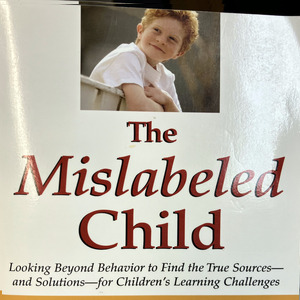Review: The Mislabeled Child by Drs. Brock & Fernette Eide

The Mislabeled Child by Drs. Brock and Fernette Eide.
Review by Kathy Kuhl
Whether you want clear explanations of particular learning problems, their causes, tools for identifying them, or practical solutions, The Mislabeled Child by Drs. Brock and Fernette Eide is a helpful and clear guide. They help families identify and build on their children’s strengths to compensate for areas of weakness. This husband and wife team is expert, practical, and positive.

This book will help you at several stages of your journey to help your child overcome academic problems. Maybe you’ve just received a diagnosis, or perhaps you only wondering your child needs to be evaluated to identify a problem. Maybe you’ve reached where I was once. As my son’s reading teacher once said, “We know he’s smart. We know he’s trying. We need to find out what’s going on.”
Fear your child’s been mislabeled? An inaccurate or overly broad diagnosis is no help. Maybe folks have said your child “just needs to try harder.” This book can give you a good foundation to your search for answers.
Don’t want your child labeled? I understand that. I don’t want my children, myself or anybody defined by their problems: “She’s ADD.” “He’s dyslexic.” We are all more than our difficulties, and none of us should be equated with our difficulties.
I love the Eides’ view of labels. They thoughtfully discuss the dangers of labels, including their tendency to expand over time, to tempt us to view a child as broken, and to ignore how environment and teaching methods may contribute. (As one speaker at the CHADD 2007 conference said, if a teacher uses the same method unsuccessfully for months, who’s the one with the learning disability?)
The Eides then explain how they use labels:
As we’ve said, the beginning of wisdom is calling theirs by their right name, not abandoning names altogether. Labels are like lenses. Used properly, they can sharpen our vision and help us see things we might have missed. … Appropriate labels can help us understand and anticipate the problems a child might face, increase our sense of empathy for her struggles, and enable us to find and deliver needed help. They can make it easier for parents, teachers, and the child himself to keep the ‘big picture’ of a child’s challenges in mind, without being overwhelmed by details. They can help us spot relationships between different learning challenges and the behaviors that accompany them, which can in turn teach us more about the underlying causes and true nature of learning challenges. (p. 8-9)
With that foundation, the Eides devote chapter two to explaining how to get the most out of the book. Each chapter, they explain, will describe the behaviors (commons signs and symptoms), causes (how the brain is supposed to function and how it functions when this difficulty is present), evaluation (how to determine if a child is suffering from this chapter’s problem), and helps: ways to strength areas of weakness, work around them, or compensate for them.
The following chapters each tackle different problems:
- Memory
- Visual problems
- Auditory problems
- Language problems
- Attention
- Autism and related disorders
- Sensory processing challenges
- Dyslexia (reading)
- Dysgraphia (handwriting)
- Math difficulties
- Giftedness
Surprised by that last one? I agree with the Eides that being gifted is a special need and that it’s not an unalloyed blessing, or as they say, “as any child who’s received a new puppy learns, even the best gifts can have their messy aspects.” (p. 432)
The Eides are medical doctors, veteran homeschoolers, and owners of the Eide Neurolearning Clinic near Seattle. They are also the authors of The Dyslexic Advantage, which is reviewed here and accompanies a useful website. The Mislabeled Child is a practical, solid, readable resource every parent of a child with learning difficulties should have. I highly recommend this book.

